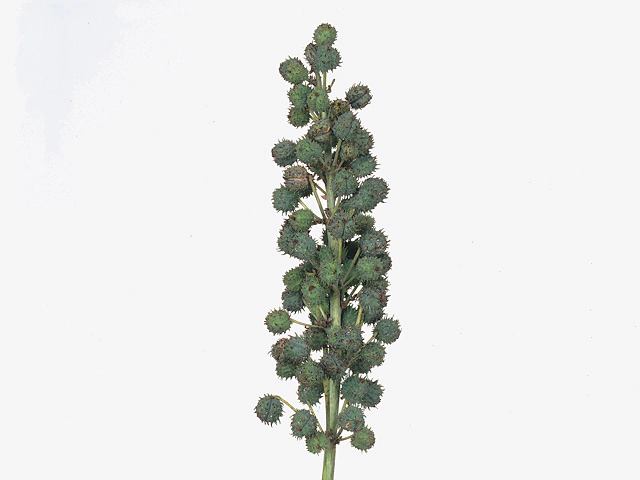Ricinus communis

| Fruit color | Green-medium brown green-139C |
The Ricinus communis, commonly known as the castor oil plant, is a fascinating species that has been cultivated for its numerous uses throughout history. One of the most interesting aspects of this plant is its unique fruit color, which ranges from green to medium brown green-139C.
The castor oil plant is native to tropical regions of Africa and its fruit, known as the castor bean, is where the valuable castor oil is derived from. These beans are enclosed in clusters of spiky, brightly colored fruits that are usually green when young and turn to a medium brown green-139C as they mature.
The fruit coloration of the castor oil plant serves multiple purposes. In its green stage, it aids in attracting pollinators such as bees and butterflies. These insects are essential for the plant's reproduction as they transfer pollen from male to female flowers, enabling the formation of seeds within the fruit.
As the fruit matures, its color changes to a medium brown green-139C hue. This transformation plays a role in signaling that the seeds are ripe and ready for dispersal. When the fruit reaches this stage, it splits open, revealing the glossy, mottled seeds within. The rich and vibrant color of the fruit ensures that it stands out from the surrounding environment, attracting attention from animals that aid in seed dispersal, such as birds and small mammals.
While the castor oil plant's fruit color is visually appealing, it is important to note that all parts of the plant, including the seeds, are toxic if ingested. The presence of toxins, specifically ricin, in the seeds acts as a natural defense mechanism against herbivores, deterring them from eating the plant.
Despite its toxicity, the castor oil plant has been widely cultivated for its economic and medicinal properties. Castor oil, extracted from the seeds, has a long history of use in various industries. It is commonly used as a lubricant, in the manufacture of biofuels, and as a key ingredient in cosmetics and personal care products. In addition, castor oil has been utilized in traditional medicine for its purgative and anti-inflammatory properties.
In conclusion, the castor oil plant, with its range of fruit colors from green to medium brown green-139C, is a fascinating species with a rich history of uses. While its toxicity may be a drawback, the plant's economic and medicinal benefits have made it valuable worldwide.
Market availability index by month:
| Jan. | Feb. | Mar. | Apr. | May | Jun. | Jul. | Aug. | Sep. | Oct. | Nov. | Dec. |
|---|---|---|---|---|---|---|---|---|---|---|---|
| 3 | 3 | 3 | 3 | 4 | 3 | 3 | 3 | 3 | 4 | 4 | 4 |